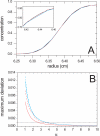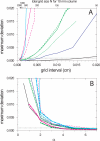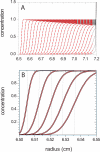A new adaptive grid-size algorithm for the simulation of sedimentation velocity profiles in analytical ultracentrifugation
- PMID: 18196178
- PMCID: PMC2267755
- DOI: 10.1016/j.cpc.2007.08.012
A new adaptive grid-size algorithm for the simulation of sedimentation velocity profiles in analytical ultracentrifugation
Abstract
Analytical ultracentrifugation allows one to measure in real-time the concentration gradients arising from the application of a centrifugal force to macromolecular mixtures in solution. In the last decade, the ability to efficiently solve the partial differential equation governing the ultracentrifugal sedimentation and diffusion process, the Lamm equation, has spawned significant progress in the application of sedimentation velocity analytical ultracentrifugation for the study of biological macromolecules, for example, the characterization of protein oligomeric states and the study of reversible multi-protein complexes in solution. The present work describes a numerical algorithm that can provide an improvement in accuracy or efficiency over existing algorithms by more than one order of magnitude, and thereby greatly facilitate the practical application of sedimentation velocity analysis, in particular, for the study of multi-component macromolecular mixtures. It is implemented in the public domain software SEDFIT for the analysis of experimental data.
Figures







Similar articles
-
A new approximate whole boundary solution of the Lamm differential equation for the analysis of sedimentation velocity experiments.Biophys Chem. 2002 Jan 23;95(1):59-68. doi: 10.1016/s0301-4622(01)00248-4. Biophys Chem. 2002. PMID: 11880173
-
Prediction and analysis of analytical ultracentrifugation experiments for heterogeneous macromolecules and nanoparticles based on Brownian dynamics simulation.Eur Biophys J. 2018 Oct;47(7):845-854. doi: 10.1007/s00249-018-1322-2. Epub 2018 Jul 20. Eur Biophys J. 2018. PMID: 30030576 Free PMC article.
-
Size-distribution analysis of macromolecules by sedimentation velocity ultracentrifugation and lamm equation modeling.Biophys J. 2000 Mar;78(3):1606-19. doi: 10.1016/S0006-3495(00)76713-0. Biophys J. 2000. PMID: 10692345 Free PMC article.
-
Analytical ultracentrifugation for the study of protein association and assembly.Curr Opin Chem Biol. 2006 Oct;10(5):430-6. doi: 10.1016/j.cbpa.2006.08.017. Epub 2006 Aug 28. Curr Opin Chem Biol. 2006. PMID: 16935549 Review.
-
Using Lamm-Equation modeling of sedimentation velocity data to determine the kinetic and thermodynamic properties of macromolecular interactions.Methods. 2011 May;54(1):4-15. doi: 10.1016/j.ymeth.2010.12.029. Epub 2010 Dec 25. Methods. 2011. PMID: 21187153 Free PMC article. Review.
Cited by
-
Calibrating analytical ultracentrifuges.Eur Biophys J. 2021 May;50(3-4):353-362. doi: 10.1007/s00249-020-01485-2. Epub 2021 Jan 4. Eur Biophys J. 2021. PMID: 33398460 Free PMC article.
-
Variable Field Analytical Ultracentrifugation: II. Gravitational Sweep Sedimentation Velocity.Biophys J. 2016 Jan 5;110(1):103-12. doi: 10.1016/j.bpj.2015.11.027. Biophys J. 2016. PMID: 26745414 Free PMC article.
-
Accounting for solvent signal offsets in the analysis of interferometric sedimentation velocity data.Macromol Biosci. 2010 Jul 7;10(7):736-45. doi: 10.1002/mabi.200900456. Macromol Biosci. 2010. PMID: 20480511 Free PMC article.
-
Best Practices for Aggregate Quantitation of Antibody Therapeutics by Sedimentation Velocity Analytical Ultracentrifugation.J Pharm Sci. 2022 Jul;111(7):2121-2133. doi: 10.1016/j.xphs.2021.12.023. Epub 2022 Jan 2. J Pharm Sci. 2022. PMID: 34986360 Free PMC article. Review.
-
Thermotolerant class A acid phosphatase active across broad pH range and diverse substrates.Protein Sci. 2025 Sep;34(9):e70244. doi: 10.1002/pro.70244. Protein Sci. 2025. PMID: 40815342 Free PMC article.
References
-
- Svedberg T, Pedersen KO. The ultracentrifuge. Oxford University Press; London: 1940.
-
- Svedberg T, Fahraeus R. A new method for the determination of the molecular weight of the proteins. J Am Chem Soc. 1926;48:320–438.
-
- Schachman HK. Ultracentrifugation in Biochemistry. Academic Press; New York: 1959.
-
- Signer R, Gross H. Ultrazentrifugale Polydispersitätsbestimmungen an hochpolymeren Stoffen. Helv. Chim. Acta. 1934;17:726.
Grants and funding
LinkOut - more resources
Full Text Sources
